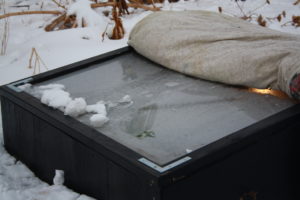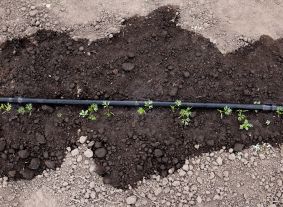How to Prepare for Spring? Make a Cold Frame
Views: 3564

I just reached into my jeans front pocket. My fingers found something more sturdy than a crinkled register receipt. Oh, right. A packet of spinach seed. Ah, it’s been a good weekend.
Winter isn’t gone yet. But warmer weather has come our way here in New England. That is, if you call high 40s/low 50s warm. We ventured out into our community garden plot yesterday to see how Old Man Winter has tread across our garden. And I can report, he has tread softly.
With recent warmish weather, it was no surprise to find daffodils emerging in the garden, and some tulips, too. Mind you, I’ve never planted them here, so these things are holdovers from a plot owner from about five years ago. I don’t coddle them or encourage them in any way, but they keep trying to win me over with each new spring. In fact, I purposefully dug up all the tulips I could find last June and threw them in the compost. Yet, I still found their telltale leaves poking through the soil. And I found the discarded bulbs pushing out yellow-green shoots in the middle of the compost pile.
Cleaning Up for Spring
We did some general-purpose, pre-spring cleanup yesterday. The parsley, whose tall and ever-durable leaves I had let succumb to the cold, looked like a melted bouquet. Still greenish, but wilted. We pulled those up.
We also gathered as many rocks (and glass shards—it is an old lot, after all) as had sifted to the surface. I always say rocks are spring’s first harvest. And of course, weeds had popped up, too, creating a tight, Astroturf-like covering in some areas.
Still, garden cleanup was’nt enough. It’s still chilly, and considering the way this winter has gone here (72 inches of snow and counting), you just never know what else will fall from the sky. But, I needed to get life going again.
This is the spring when I get a cold frame.
Making a Cold Frame
The 2-foot-wide, 3-foot-long, and 2.5-foot-deep frame in which I grew carrots last year is my road to early-spring spinach and baby carrots.
Today I turned it into a makeshift cold frame. First, I sprinkled some of my rich compost on top of the box’s soil—maybe 3 inches or so—and worked it in. While churning, I hit a still-solid pack of frozen soil right in the middle of the box. Soil in a raised bed is supposed to warm up more quickly than the ground, in general. I think in this case the center is still frozen, but the soil surrounding that chunk was warmer than the ground soil.
We planted one row of Kuroda carrots, one row of Babette carrots (the baby ones), and one row of reaching-into-my-pocket spinach, a variety called Tyee. I received it as a free sample from Sakata Seeds. Let’s see how that goes.
The soil was still quite moist. It has rained recently, so there was no need to water.
And then I simply laid a piece of 24-by-48-inch plexiglass (trimmed to about 40 inches) on top of the box and secured it by putting some bricks on the corners. I do plan on putting a thermometer inside to see how warm it becomes. On sunny days, I’ll prop open the plexiglass to make sure it doesn’t heat up too much in there. I want it warm, but not blistering.
Take that, Old Man Winter! Spring and I are encroaching on your territory.
Meet Ellen Wells
When you’re raised on a farm, you can’t help but know a thing or two about gardening. Ellen Wells is our expert on edible gardening.…
Ellen's Recent Posts

Asparagus






